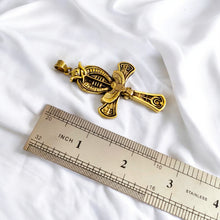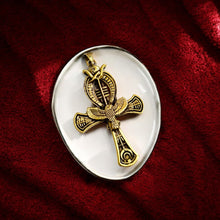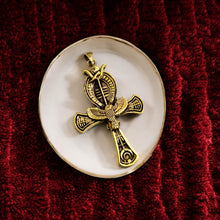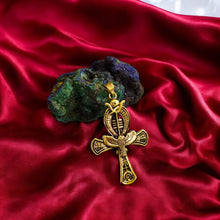Djed Piillar Horus Ankh Gold Pendant Necklace
- Regular price
- $75.00 USD
- Sale price
- $75.00 USD
- Regular price
-
- Unit price
- /per
Adding product to your cart
The Djed Pillar Horus Ankh Gold Pendant Necklace combines ancient Egyptian symbolism—such as the Djed pillar representing stability, the Horus falcon symbolizing protection, and the Ankh signifying life—with modern luxury, reflecting millennia-old traditions in contemporary jewelry design.
- History: Inspired by ancient Egyptian symbols: Djed pillar, Horus eye, Ankh.
- Spirituality: Represents stability (Djed), protection (Horus), and life (Ankh).
- Talisman: Believed to bring strength, protection, and vitality.
- Handmade: Crafted with care using traditional techniques.
- Healing: Thought to promote spiritual well-being and positivity.
- Material: Made from genuine gold for durability and elegance.
- Symbolism: Djed for stability, Horus for protection, Ankh for life and immortality.
- How to Wear: Fits any chain up to 5mm, ideal for daily wear and layering
History Side For Those Who Are Interested
The Djed pillar, Horus, and the Ankh are significant symbols in ancient Egyptian culture, each with its own rich history and symbolism.
The Djed Pillar: The Djed pillar is one of the oldest and most recognizable symbols in ancient Egypt. It is typically depicted as a column with a broad base narrowing as it rises, often ending in four crossbars at the top. The exact meaning of the Djed pillar is complex and multifaceted, but it is generally associated with stability, endurance, and strength. It is closely linked to the god Osiris, the god of the afterlife, resurrection, and fertility. The Djed pillar is sometimes interpreted as the backbone of Osiris, symbolizing his eternal nature and role in the afterlife. It was also believed to represent the concept of stability and the enduring power of the pharaohs.
Horus: Horus is one of the most significant ancient Egyptian deities, often depicted as a falcon-headed man or as a falcon itself. He was originally worshipped as a sky god and was later associated with kingship and protection. Horus is perhaps best known for his role in the Osiris myth, where he avenges his father Osiris by defeating Set, the god of chaos, in a series of battles. This mythological conflict symbolizes the eternal struggle between order (Horus) and chaos (Set). As a symbol, Horus represents kingship, divine rule, protection, and justice. The Eye of Horus, an ancient Egyptian symbol of protection and power, is also widely recognized.
The Ankh: The Ankh, also known as the key of life or the key of the Nile, is another iconic symbol of ancient Egypt. It resembles a cross with a looped top and is often interpreted as a symbol of life and immortality. The looped top is thought to represent eternal life, while the cross-like shape represents earthly existence. The Ankh was commonly used in Egyptian art and religious iconography, often being held by gods and pharaohs as a symbol of their divine power and authority. It is closely associated with deities such as Osiris and Isis and was believed to hold the key to eternal life and the afterlife.
Historical Context: These symbols were integral to ancient Egyptian religious and cultural practices, permeating all aspects of life from art and architecture to religious rituals and funerary practices. They reflected the Egyptians' profound beliefs in the afterlife, resurrection, and the eternal nature of the soul. The Djed pillar, Horus, and the Ankh continue to captivate and inspire fascination due to their enduring symbolism and the profound insights they provide into ancient Egyptian beliefs and worldview.
In conclusion, the Djed pillar, Horus, and the Ankh stand as enduring symbols of ancient Egyptian civilization, representing stability, kingship, protection, eternal life, and the divine order that governed their worldview. Their significance continues to resonate in modern times, offering a glimpse into the spiritual and cultural depths of one of history's most remarkable civilizations.
















